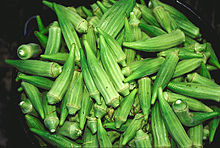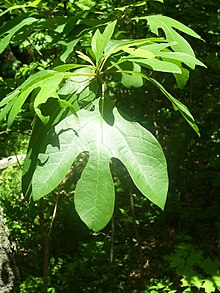Gumbo
[1] Gumbo consists primarily of a strongly flavored stock, meat or shellfish (or sometimes both), a thickener, and the Creole "holy trinity": celery, bell peppers, and onions.
Gumbo is often categorized by the type of thickener used, whether okra or filé powder (dried and ground sassafras leaves).
The dish combines ingredients and culinary practices of several cultures, including African, French, German, Spanish, and Native American Choctaw.
Additionally, the native Choctaw people used filé - dried, ground sassafras - leaves to thicken soups and stews.
[9] Andouille sausage is often added to both meat and seafood gumbos to provide "piquancy, substance, and an additional layer of flavor" to the dish.
[14] According to The Oxford Companion to Food, okra-based gumbos are becoming less popular, as the okra texture has become less palatable to changing tastes.
[15] Ground sassafras leaf, known as filé, is generally not added to the gravy until after the vegetables and meats or seafood have finished cooking and have been removed from the heat source.
"Cajun" combinations were common in southwestern Louisiana, which was populated primarily by Cajuns, descendants of the French-speaking settlers expelled from Acadia (located within the modern-day Canadian provinces of Quebec, Nova Scotia, New Brunswick and Prince Edward Island) in the mid-18th century.
[12] Seafood is popular in gumbo the closer to the coast the people are, but the southwestern areas of Louisiana often use fowl, such as chicken or duck, and sausage.
[25] French settlers allied with various native tribes including the Choctaw, Alabama, and Cherokee,[26][27] from whom they learned new methods of cooking and ways to identify edible indigenous plants.
[35][36] These settlers were primarily fishermen who soon began supplying large amounts of shrimp, crab, and oysters to the food markets in New Orleans.
[36] Spanish authorities also granted permission for many French-speaking Acadian exiles to relocate from northeastern North America to Louisiana.
By 1800, the slave trade had introduced new foods to Louisiana, including the African vegetable okra,[38] and hot pepper plants which likely came from Haiti.
Enslaved African Americans often exchanged or combined ingredients in order to make the dish, allowing it to serve as a means of community and identity.
[39] When the Acadians moved to Louisiana in the mid-18th century, they were unable to find many of their traditional ingredients, including turnips and cabbage.
According to legend, in 1722, female French colonists gathered in New Orleans at the home of Governor Jean-Baptiste Le Moyne, Sieur de Bienville, to protest the lack of familiar ingredients.
In 1802, John Sibley described "the dish they call gumbo which is made principally of the ochre into a thick kind of soop [sic] & eat with rice, it is the food of every body for dinner and supper.
"[43] The following year, French governor Pierre Clement de Laussat hosted a soirée in which 24 different gumbos were prepared.
According to author Cynthia Lejeune Nobles, these two events "give clues to gumbo's Spanish colonial popularity and illustrate that the dish could be both humble and refined".
The same book contained a recipe for "Ochra Soup" made with okra, onions, fowl, bacon, tomatoes, and lima beans thickened with flour.
A native of Terrebonne Parish, Louisiana, Ellender had often cooked gumbo for his colleagues, including five American presidents.
After Ellender died in 1972, the Senate directed that their cafeteria add Louisiana Creole Gumbo, made with seafood, to its menu in his honor.
According to Nobles, "proper seasoning of gumbo is essential, and in Louisiana adding just the right zing is considered an art".
[14] Creole and Cajun gumbos are served with hot rice,[27] which stretches the quantity of the dish for maximum portion sizes.
[14] Gumbo is almost always served directly from the pot on the stove, although in wealthier or fancier homes the dish might be transferred to a tureen on the table.
[46] Often, gumbo and bread are the sole courses in a meal,[8] although many Cajun families provide a side dish of potato salad.
[48] In Cajun Foodways, C. Paige Gutierrez describes gumbo as "an economical dish" useful for "feed[ing] a large number of people with a small amount of meat or seafood".
[9] Nobles concurs that "one of the hallmarks of gumbo is that, with a big enough pot, it can easily be doubled or tripled and is always a good choice to feed a crowd".
In rural Acadiana in southern Louisiana, gumbo is a central feature of Mardi Gras celebrations.
[5] Many southern Louisiana cooking competitions center around gumbo,[10] and it is a central feature of many local festivals.




